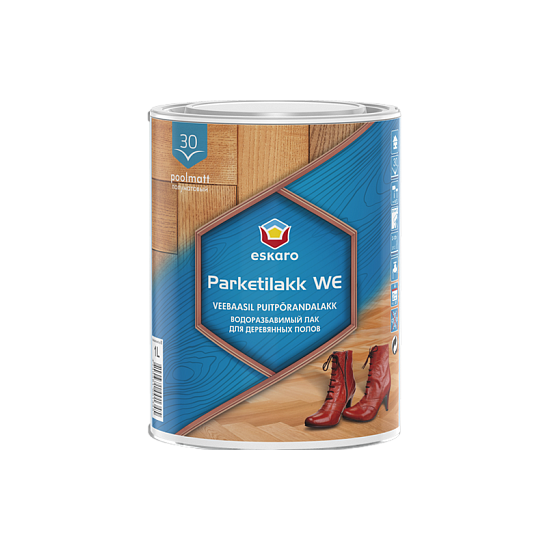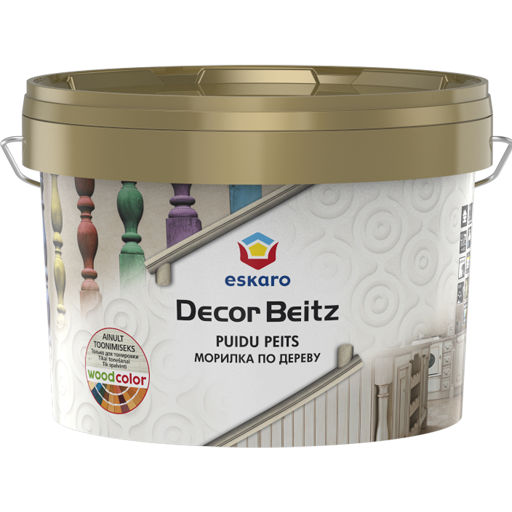Properties
Durable acrylic varnish for interior use.
- Easy to apply; spreads evenly on the surface.
-
Semi-matt surface subtly enhances the beauty of natural parquet floors.
-
Dries and reaches peak hardness quickly.
-
The surface is resistant to washing and exposure to household chemicals.
-
Does not discolour to yellow.
-
Odourless
Maximum permissible EU VOC content for the product (subcat e): 130 g/L. Maximum VOC content in the product <130 g/L
Gloss:
- semi-matt in accordance with EN 13300
Purpose
Primary and maintenance floor varnishing in living quarters and public halls.
Not suitable for varnishing floors in sports halls.
Type of surfaces to be treated
New or previously varnished wooden surfaces and parquet.
Can be used for floating (vibrating) floors, plank floors, sheet parquet and parquetted heated floors.
Quality standards
- EN 13300 [Paints and varnishes. Water-borne coating materials and coating systems for interior walls and ceilings. Classification] – classification standards of coverage, gloss level and wet abrasion resistance parameters for water-borne coating materials for interior walls and ceilings.
-
VOC (volatile organic compounds) – content in accordance with the European Union directive 2004/42/CE.
- Product and service quality is guaranteed by the quality, environmental protection, occupational health and safety management system in accordance with standards ISO 9001:2015; ISO 14001:2015 and ISO 45001:2018
Surface preparation
Wood moisture content must not exceed 12%. Perform application at the temperature between 18 °C and 25 °C, relative humidity between 40% and 75%, and varnish temperature between 15 °C and 25 °C. Clean the surface from dirt, grease, oils, silicone or wax. Dampen rough surfaces, using a spray, let them dry and sand off the fibres of wood raised by dampening. Before finishing previously varnished surfaces, make a varnish swatch on a small surface patch to check that the varnish will match the material of the old floor.
Previously varnished surfaces do not require preliminary priming; they need to be thoroughly cleaned from old peeling varnish, carefully sanded and cleaned from dust.
Use coarse sandpaper and apply firm pressure for the first sanding; make sure to sand the surface as smooth as possible.
Use fine sandpaper and apply low pressure for the last sanding.
Sanding removes individual fibres and improves adhesion with further coats of varnish.
Sand softwood surfaces with care, using fine sandpaper (120–150) and applying low pressure for the final sanding to prevent excessive pressing because fibres will rise and the surface swell when water soaks such wood, and the floor can bulge.
Sand the surface along the grain of the wood or in the direction of the light from the window.
Use a vacuum cleaner to carefully remove any dust from the floor, baseboards, windows and radiators after sanding. Then wipe the surface with a clean damp non-pile cloth.
For priming new non-varnished surfaces, apply a coat of ParketiLakk WE varnish (diluted in water by 10-15%), let it dry, sand the surface with fine sandpaper and clean it from dust.
Application
Do not perform the application in direct sunlight, at high temperatures and in case of exposure to draughts.
Before application and in the process of working, stir the varnish thoroughly but carefully (to make sure you do not cause air bubbles to form in it). Stirring ensures that the gloss of the varnish coating will be even when it dries.
Apply 2–3 coats of ParketiLakk WE varnish on the prepared surface with a roller (or 4–5 coats with a varnish applicator) along the grain of the wood or in the direction of the light from the window.
The number of varnish coats depends on the porosity of the wood and the instrument you use.
Sand the surface with fine sandpaper (120–150) to remove raised wood fibres and remove dust after applying the first finishing varnish coat.
Use a vacuum cleaner to carefully remove any dust from the floor, baseboards, windows and radiators after sanding. Then wipe the surface with a clean damp non-pile cloth.
The surface does not need intermediate sanding between the following coats of finishing varnish.
Only apply each following varnish coat after the previous coat has fully dried.
Do not apply more than two coats per day to make sure that the varnish dries faster.
Leave the varnished surface to dry for the night before applying the last coat.
If you spill the product on the floor, spread it upon the surface immediately to make sure that wood does not absorb excessive moisture.
Make sure the working area is well-ventilated, but with no draughts that can cause surface defects.
If you use exotic or unknown wood species, we recommend making a varnish swatch. Some wood species can change their colour dramatically or get stains.
Soft plasticised materials, for example, carpet flooring, castor chairs, and furniture legs can cause the varnish to become soft and change colour.
If tinting is necessary, we recommend using the Décor Beitz or Wood Lasur Aqua decorative wood protecting coating (in supplied colours or tinted according to the ‘EskaroColor system) as the first coat.
Use the colourless Parketilakk WE varnish for the following coats.
Care for the treated surface
The coating reaches its peak wash resistance in about one or two weeks; in the meantime, treat the surface with care until its hardness and wash resistance have reached their peak levels.
If necessary, the surface can be lightly wiped with a soft sponge or cloth approximately 48 hours after varnish application.
We recommend using water and neutral or medium alkaline detergents (pH below 9) for washing the varnished surface.
Do not use organic solvents, abrasive cleansers and hard scrubbing brushes or sponges.
Tools
Stainless steel padded applicator, roller brush.
When applied with an applicator, little of the varnish is absorbed by the wood, which results in its lighter colour. The blade of the applicator must be flexible enough to follow the roughness of the floor and sufficiently sharp for the applicator to act as a knife and smooth down protruding wood fibres.
When choosing a roller to apply the varnish, always use a clean dry roller without loose pile. Even if you use a new instrument, remove excess pile and loose fibres first (with scotch tape or a comb, for example).
Tool cleaning
Wash with soap and water after completing work.
Colour |
White; transparent after drying |
Consumption |
8–14 m2/L (70-120g/m2) when applied with a roller; first coat ~25m2/L (~40 g/m2); second coat ~50 m2/L (~20 g/m2)
The overall varnish
consumption recommended for ensuring maximum coating durability is 3-3.5 m²/L
(~300 g/m²). |
Drying time |
At the temperature of +20°C and the relative humidity of 65%, 0.5–1 hour when applied with a varnish applicator and 1–2 hours when applied with a roller.
The floor can withstand light loads after 24 hours, and peak resistance is reached in 1–2 weeks.
Do not perform wet cleaning or lay carpet flooring during this period.
If the temperature is lower and the humidity is higher, the drying takes longer accordingly.
|
Store
and transport in undamaged containers at the temperature between +5°C and +30°C.
Protect from freezing and direct sunlight.
Volume / weight
1 L – 3 L – 5L
Frost resistance |
None |
Density |
1 kg/L |
 EST
EST


 Download Technical Data Sheet
Download Technical Data Sheet






 Decor Beitz
Decor Beitz 




